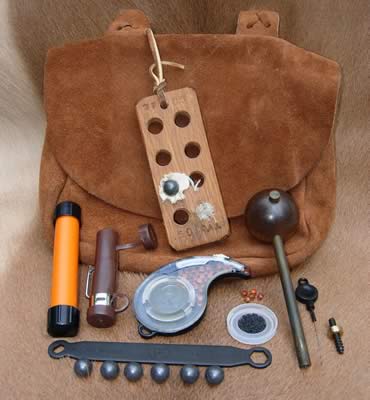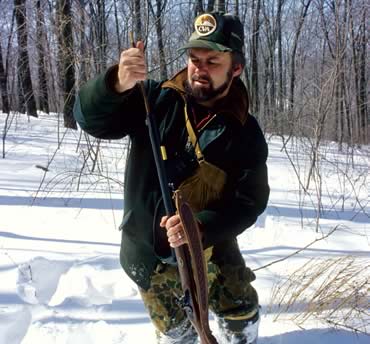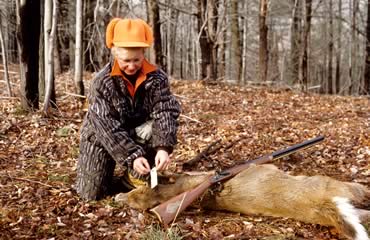One of the most important skills of blackpowder hunting is the ability to reload quickly.
Serious blackpowder hunters spend considerably more powder and lead under the controlled conditions of a shooting range than they do in the field. At least they should. Those who practice learn crucial lessons and skills that can make or break a hunt. One oft-ignored skill is the ability to quickly load your muzzleloader.
If you shoot blackpowder long enough, it’s just a matter of time before you’re faced with a situation that requires a quick reload, especially if you shoot a flintlock. The same is true for inline shooters, but we’ll focus on flintlock and percussion cap muzzleloaders here, since that’s what we must use in my home state.
Over the years, I’ve noted a surprising number of blackpowder hunters insist that there’s no need to reload quickly — one missed shot and the game’s over, they say.
Not necessarily. Even if the deer is hit but not killed, it pays to reload quickly. My initial need to develop a fast and efficient reload technique for flintlocks or caplocks occurred during the first Pennsylvania flintlock-only season in the mid-1970s. A couple days after Christmas, three of us decided to push a well-tracked thicket before taking our evening stands.
 I was in place less than 20 minutes when movement in the brush about 75 yards off caught my eye. It was a grazing doe, unaware of my presence and that of my buddies, Jim and Dave, sneaking toward her somewhere below in the sticker patch. I waited patiently as the big doe worked to a small clearing and stood broadside at about 60 yards. I rested my gun on a low limb and positioned the flintlock’s iron sights just behind the doe’s shoulder and fired.
I was in place less than 20 minutes when movement in the brush about 75 yards off caught my eye. It was a grazing doe, unaware of my presence and that of my buddies, Jim and Dave, sneaking toward her somewhere below in the sticker patch. I waited patiently as the big doe worked to a small clearing and stood broadside at about 60 yards. I rested my gun on a low limb and positioned the flintlock’s iron sights just behind the doe’s shoulder and fired.
Before the smoke cleared, she was gone, as evidenced by several flashes of a white tail bouncing through the brush in the opposite direction. I stumbled to where she’d been standing, but all I found in the three-day snow were tracks.
As I cursed my luck, fate offered a second chance. Two more does, probably spooked by the drivers, sprinted from cover, then stopped 40 yards away, obviously confused.
Do It Again
My first reaction, after 20 years of hunting with modern rifles and slug-loaded shotguns, was to take quick aim and shoot again. Problem was, my flintlock was empty. And my movement — or the thick, white smoke cloud in the still air — had caught one of the does’ attention.
I knelt behind a cluster of weeds, hoping they’d continue to be curious for a minute or two as I fumbled through my possibles bag to retrieve one of several 35mm film containers in which I stored premeasured powder chargers.
As I attempted to pour the FF blackpowder down the muzzle, half of it went into the barrel where I wanted it, and the rest drizzled onto the snow. Knowing this wouldn’t work, I uncapped another container and nervously managed to get another 50 percent of my 90-grain load down the hand-fashioned long rifle’s barrel.
To make things more comical, one of the does stared me down, but she seemed more confused than frightened.
Next came patching the ball and trying to short-start it into the barrel. That was followed by removing the full-length wooden ramrod and pushing the ball down the remainder of the fouled barrel. The whole job took about three minutes, which seemed like three hours. By that time, the deer had seen enough. My effort had been an obvious — yet invaluable — failure.
 Third Time’s the Charm
Third Time’s the Charm
Those were my first and second opportunities to shoot a whitetail with blackpowder, and they taught me the importance of practicing my quick-loading technique on the range, not in the field with deer (and maybe a hunting buddy or two) watching. It’s good no one carried video cameras back then.
A couple of years later, another miss from a treestand happened as a small forkhorn buck stood at 50 yards. I’ll save the details. Suffice it to say that having practiced my quickloading technique on the range paid off. The deer was unnerved by the initial blast and belch of white smoke. It stood its ground and flicked its tail and ears as I managed to ram a quick load into the Hawken and fire again, this time making good.
Quickloaders
A quick-loading device had saved the day. My first quickloader, which I still carry from time to time, is largely a tool used by serious buckskinners. It’s called a “bullet board” or “loading block,” made for holding pre-patched and lubricated roundballs or conical bullets. The half-inch-thick block of wood with four holes (or more), each precisely drilled to hold a .45-caliber ball and a greased cotton patch. Primitive, yes, but functional.
With a premeasured powder charge first poured down the barrel, all I had to do was line up the hole with the muzzle and push the ball and wad into the barrel with a short-starter (essentially a short ramrod), followed by ramrodding the entire load. It cut my reloading time by at least 50 percent.
Today, just about every muzzleloader manufacturer and accessory supply house makes some sort of quickload device. The simplest are firm plastic tubes with removable caps on each end. Both the premeasured powder charge and the projectile are held in one unit. Reloading afield is simplified as the cap is first removed and the powder poured down the barrel. A short-starter is used to push the projectile through the tube and into the muzzle before being driven home by the standard ramrod. Be sure to purchase the proper size quickloads, which come in .45, .50, .54 and .58 calibers.
Oh, yes, and in all the excitement, try to remember the muzzleloader gunner’s creed: “Powder first, projectile second.”
 Possibles Bag
Possibles Bag
Organizing things in a possibles bag is the key to making certain everything runs smoothly in the reloading process. What you do at home to get the bag ready before the hunt has everything to do with how rapidly you can find your reloading components in the bag, reload the gun and finish things off with panpowder or a percussion cap.
Included in the way of necessary gear for all reloading are a short-starter, pan charger (for flintlocks), a capper (for attaching #11 percussion caps to the nipple), bullet bag (a small pliable bag for carrying projectiles), speed loader (which holds all load components at ready), loading block (the primitive device discussed previously), capped plastic tube-type loader, ramrod attachments (for removing a stuck patch or ball) and other accessories used in standard reloading gear.
Hone on the Range
Now that the possibles bag is equipped for getting off that second shot, what remains is honing your loading skills on the range. Make it fun. Bring a friend and have a contest using a timer, with the loser buying lunch. Such on-range practice sessions will help you decide if your possibles bag is arranged for quick retrieval of the components. Of course there’s no guarantee on a hunt. Focus on the job at hand, but keep in mind that things aren’t quite the same with a 6-pointer staring at you 50 yards away, wondering what the loud blast and the white smoke was all about.
Read Recent Articles: • Deer Pelletology: Can hunters learn anything useful from deer droppings?
• Making It Count: Missouri teenager makes the most of his last season as a youth hunter.
• If Mama Ain’t Happy: Bucks get all our attention, but the life and habits of does are just as interesting.
This article was published in the Winter 2008 edition of Buckmasters Whitetail Magazine. Join today to have Buckmasters delivered to your home.